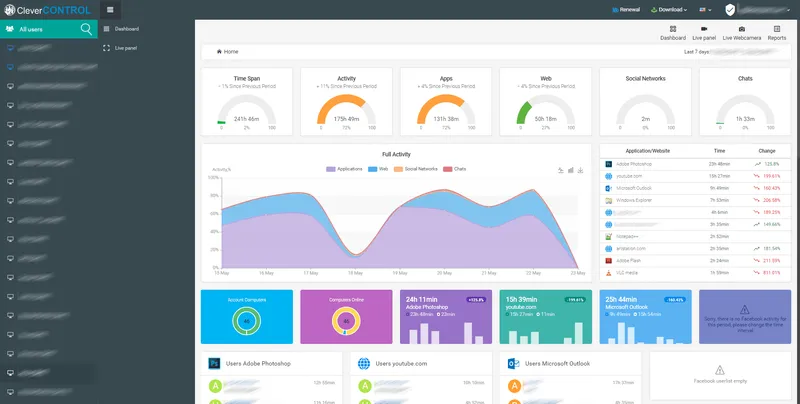

How To Monitor Employees' Productivity?
Control over employees' work is a set of measures to maintain the personnel's effectiveness during working hours. In other words, monitoring employees' work allows CEOs and HR managers to ensure that their employees are busy solving job tasks instead of matters not related to work.
There are several main reasons why employees are inefficient at work. It can be connected with the lack of interest in their responsibilities, demotivation, or working overtime. The manager's primary task is to competently organize the personnel's work so that every team member performs their duties and does not shift responsibility to others.
This article will look through the most effective employee monitoring methods that will increase your staff's productivity.
Watch employees work with your own eyes.
Visit the office regularly and check how your team members work yourself. Your unexpected visits will make your employees understand that the CEO can come at any moment and ask what has been done during the day. While asking for reports, remember to ask if the employee has any questions or concerns about their task or ongoing project. Note that unclearly stated tasks can also influence your team's productivity.
Create healthy competition.

Competition between different departments is a common practice that will allow you to track your employees' involvement in the business processes. If you understand an employee's behaviour, you can control your team more efficiently by identifying their strengths and weaknesses.
Ask for regular reports.
While ordinary employees can work hard and perform all their duties, the head of a department can be lazy and transfer their daily tasks to other coworkers. The head of the department can be the reason for the non-fulfilment of critical tasks. To solve this problem, CEOs should ask the managers for regular reports and continuously check completed tasks. By submitting weekly or monthly reports, managers indicate their department’s ongoing projects and their teams' specific actions taken to complete a particular task. Based on the data obtained, you'll see how much time your employees spend productively. Additionally, reports will help you identify the issues your employees face while working on a project, which will help you optimize the business process, help your team cope with all problems and avoid employees' demotivation.
Promote a work-life balance.
Respect a work-life balance and make sure that nobody works overtime in your company. It's strongly recommended to encourage small breaks throughout the day for your staff. Make sure that your team members get away from their desks periodically and take their minds off work. Consider tracking time when employees go home and ensure that nobody works overtime.
Use employee monitoring software.

If you don't have time to track your employees' activities at work, install an employee monitoring program to keep an eye on the personnel's activities remotely. Such software allows you to control your staff even if you're on a business trip or have a day-off. Time-tracking and employee monitoring solutions allow you to capture all user activities on the PC and check if your team members are efficient at work. For example, employee monitoring software CleverControl records the screens of employees' desktops. It can record calls to the company's customers so that you could check how your team members perform their daily duties. Other than that, employee monitoring software can prevent data leakage and help you investigate employees' unlawful actions.
Appoint daily meetings.

Daily meetings are intended not only for listening to employees' reports. Visual demonstration of the company's achievements motivates your team members. A daily meeting is the best time to praise hard-workers and point out who in your staff could work harder. Such management provides:
- Clear KPIs.
- An employees' understanding of their responsibilities.
- The rewards they may get or ways of punishing non-efficient team members.
Ask your customers what they think about the services your company provides.
Make a kind of research and contact multiple clients of your company. Find out if they are satisfied with your company's services and what can be improved in the future. If your employees are aware of your regular communication with their clients, they work more effectively to provide the service you expect. Additionally, mutual contact with clients will help you identify business processes issues and resolve them unless they become a real problem.
Implement mystery shopping.
Along with daily meetings, this type of control is one of the most universal. In brief, a trained person plays the ordinary client's role and checks how your employees work when they are not aware of the check. Such a method gives an employer a clear picture of the team's competence and professionalism and helps you understand what you need to do to improve employees' performance.
Help your team use self-monitoring tools.

Help your employees use self-monitoring tools, including checklists, project plans and activity logs. Employees can easily monitor their progress themselves and report to their managers daily. Activity logs can be represented in charts and show what tasks the team member completed and how much time it took. In this way, employees will get a clear picture of how much time they spend on business tasks and how much time they waste smoking or chatting with colleagues.
Motivate your employees.
Whatever employee tracking methods you select, remember that employees' motivation and commitment are the best ways to increase employee productivity. Motivating employees influences work processes when your team members feel your recognition of their contribution to work results. Furnishing the office, invitations to prestigious meetings or meaningful negotiations emphasize the employee's position in the colleagues' eyes. Be careful with this method: partial or complete deprivation of an employee of a previously granted status can offend an employee and lead to dismissal.






